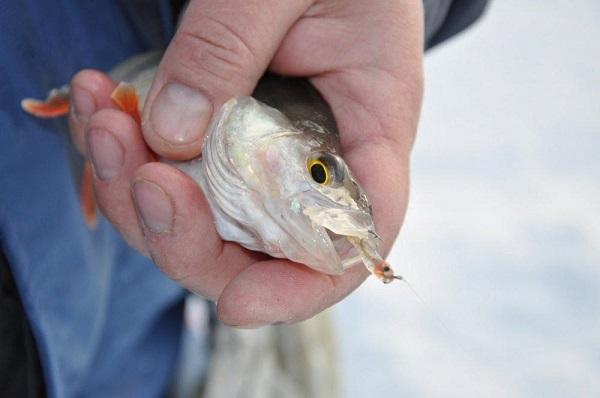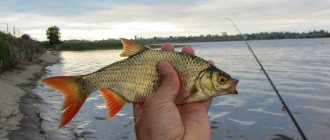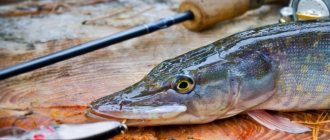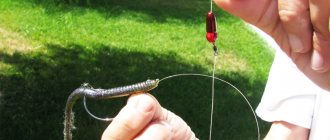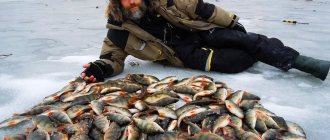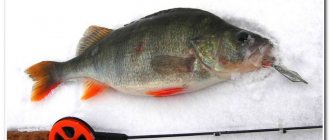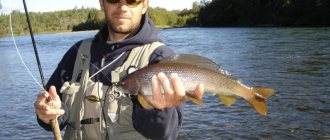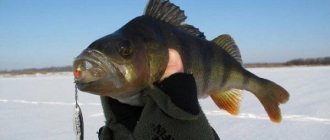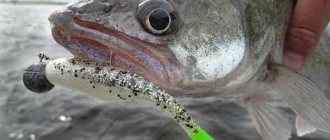Equipment for fishing with a steam locomotive
The success of any fishing is determined by well-chosen tackle. You should choose a fishing rod with a reel in such a way that all the equipment with several baits is optimally positioned, and there are no difficulties when casting and retrieving.
- In order for the nod to have sufficient sensitivity, its length is selected taking into account the fishing conditions. The value can vary between 100-150 mm. The material for making the nod is selected depending on the number of baits. If the “locomotive” is relatively small and light, then a plastic nod is sufficient. When a lot of baits are used and the “locomotive” is heavy, preference should be given to a metal nod.
- Based on the total weight of the lures, not only the type of nod is determined; it is taken into account when selecting a fishing line, giving preference to diameters of 0.10-0.18 m. The selected option should provide tension on the fishing line with the lures, which will ensure a good game.
- There are many options for selecting and combining baits for such gear. A tandem of two “devils” is considered effective. Various combinations of their weight and size make this combination very catchy. The main thing is that each such combination requires its own game.
- The classic “locomotive” made from a jig and a “devil” has also proven itself well; The tackle with a massive “devil” at the bottom and a small jig at the top is especially productive. For greater attractiveness, one or more beads are installed on the jig, the colors of which would differ sharply from each other.
Steam locomotive on a fishing line
There are two fundamental options for such gear. One is that there are two baits of the same type on the line. The second rig option assumes that these two baits are different in nature. Let's start with the first one. In certain fishing conditions, it happens that you cannot get by with just one bait. For example, when fishing in a current, it is not possible a jig or a “ devil Increasing the mass of the bait leads to an increase in its size. But in moments of inactive biting, it is the size of the bait that is often decisive. Moreover, it also happens that the current is so strong that increasing the size of the jig to the size of a spinner does not lead to the desired result. In this case, the traditional combination of sinker-jig or sinker-hook is clearly used. Another case. Fish can be caught from very deep depths, but only with small baits. In this case, I always remember catching smelt from a depth of 16-20 m. The time of lowering the bait becomes commensurate with the time of the angler’s patience, or even the duration of the fishing itself. What to do? The simplest option is to attach additional weight to the fishing line. Sometimes this is good, but more often it is bad. Let's take, for example, a jig . Additional weight can be placed above the jig on the main line or below the jig on the extension of the line. The first option is bad because when the mass of the additional sinker is comparable to the mass of the jig, it becomes quite difficult to control such stages of the retrieve as touching the jig to the bottom, lifting it from the bottom and moving the jig along the bottom. But these are often the most effective movements of the jig during a careful bite. The main thing is that these techniques are only effective when performed very, very accurately. The sinker on top so conceals the movements of the jig itself that there is no need to talk about the accuracy of the execution of these techniques or any kind of play of the jig in general. Significantly better results are obtained if the sinker is located at the end of the fishing line, and the jig is slightly higher. But this option also has a significant drawback. The distance between the sinker and the jig limits the distance of the “game” wiring of the jig. As soon as the sinker comes off the bottom during the retrieve, the tackle completely loses sensitivity due to the fact that the nod becomes overloaded. If the distance between the jig and the sinker is increased, then problems begin with the drift of the jig in the current. But in the end, the better option is when the sinker is below and the jig is above. It should be noted that this type of equipment is most effective when fishing for roach in reservoirs without a current from a depth of more than five meters. Much less often, such equipment brings success when catching bream under conditions of careful biting on the smallest baits. Such equipment is very effective during the “hunt” for ruff “by ear”, during the “dead winter” period. The fact is that during this period the ruff is at a depth, and pulling out one and a half to two grams of “marketable” fish from five to ten meters is a very technically difficult and emotionally tiring task. We can say that combining a jig with a sinker is a classic option, which historically appeared one of the first. However, our, that is, Russian fishermen, the founders of jig fishing, quickly realized that the sinker could be replaced with another jig. The appearance of two jigs on one line made it possible to experiment. That is, put jigs of different shapes, sizes and colors, put a bloodworm on the hook of one jig, a “burdock” (a worm, a piece of lard, maggot, etc.) on the hook of another, etc. That is, the appearance of creating a more universal tackle has appeared. This is an appearance. Because the tackle has lost sensitivity and controllability under conditions of ordinary, let’s say not extreme, fishing. And most importantly, the individual approach in selecting a game for a specific jig is lost. First, about sensitivity. The sensitivity of the gear is determined by its ability to react and record fish bites. When fishing with a jig, the reaction of the tackle to a bite is expressed in the movement of the nod. Installing two jigs and increasing the mass of the bait leads to the use of a stiffer, and therefore less sensitive nod. This is unreasonable during fishing, when you can get by with one jig, and justified when it is necessary to lower a shallow bait to great depths or in current conditions. Now about handling. It is no secret that for each jig it is necessary to select a nod, the size of the bait, and the game. Moreover, the optimal game changes not only from the activity of the fish, but also from the depth. Now let’s imagine that there are two different jigs on the fishing line. One is a “ball” and the other is a “bug”. And what should the game be like? It is clear that it will not be possible to combine the play of two different jigs, since, by and large, neither of them will play. The game will be effective only if the jigs have a “non-playing” shape. Non-playing forms include jigs in the shape of a ball, a column and “devils”. These jigs have virtually no natural vibrations in any plane. Therefore, you can tie at least ten “devils” on a fishing line, their “game”, that is, the absence of game, will not change. Therefore, installing two jigs of different types or the same type, “playing” or “non-playing,” on a fishing line leads to the fact that the jigs become sinkers with a hook. That is, carriers of bait or bait. In fairness, it should be noted that if you fish constantly in the same place, from the same depth, as fishermen living near a reservoir do, then you can create a “game” rig from two jigs by painstakingly selecting the diameter of the fishing line, the length and stiffness of the nod and the distance between jigs. The most difficult thing in such a selection will be finding the distance between the jigs in accordance with their mass, since joint play will be observed only in the event of resonance. Now imagine that after many hours of selecting and adjusting the tackle, you broke it! As practice shows, the only viable option for combining two jigs on one line is a “locomotive” of two “devils”. The area of use of such gear is a body of water with a current. The main object of hunting is bream. You can “hang” two completely identical “devils”, but this is advisable when you know exactly their “working” sizes and color. Otherwise, it is better to take one “devil” in black, and the second, for example, green or purple. You can tie a large “devil” below and a small one above. This makes sense only when almost all bites occur at half-water. You can, on the contrary, tie a small “devil” below and a large one above. This option can be effective in very strong currents. The distance between the “devils” can be very different, and each time it has to be selected. It depends not only on the depth, strength of the current and the mass of the “devils”, but even more on the activity of the fish. The game with such tackle is very simple and unpretentious. The lower “devil” is lowered to the bottom or to the bottom and the “locomotive” begins to be raised - up to a height of sometimes two meters from the bottom. This is the simplest wiring, which usually “works” in the current. For variety, during lifting the equipment can be rocked, but stopped periodically. Often the most effective retrieve is to simply lift the rig, stop it, and hold it in place. It is very rare, and this applies more to sea fishing, that there are two vertical spoons on one rig. This type of gear is sometimes used when fishing for perch and whitefish. The spoons used are narrow, like a clove, but sometimes BOTTOM, a heavy jig-type spoon is attached, and a light gliding one is attached higher on the leash. In general, it should be noted that the “locomotive” of two baits of the same type is not the most interesting option and they use it either out of old memory, or because of the hopelessness of the situation in which the fisherman accidentally finds himself. An order of magnitude more interesting is the equipment that uses different types of bait, for example, jig-spoon, spinner-streamer, “devil” - “fly” and others. We will continue to talk about this in the next issue of the newspaper. So, today we will talk about rigs that combine different types of bait on one line. The first time I came across such gear in practice was while fishing on Lake Peipsi. It was brought by fishermen who had previously fished in the Baltic Sea. The tackle was a large oscillating “summer” spoon at the end of a fishing line. Of the familiar spinners, it most closely resembled the famous “Storling”. It is characteristic that the tee was removed from the spinner in advance, since they did not count on bites from the spinner. The spoon was attached to a fairly thick fishing line with a diameter of 0.25 mm. Above the spinner, about thirty to forty centimeters, on a very short two-centimeter leash made of fishing line with a diameter of 0.17 mm, they tied small jigs, onto the hooks of which they attached large bloodworms. The fishing technique with such gear was as follows. The spoon was lowered to the bottom, a dozen gentle strokes were made and the spoon was lowered to the bottom. Now it was the turn of the jig. The jig sank to the bottom and then everything happened as usual. That is, the jig was given one or another game. If there were no bites within three minutes, then the fisherman repeated the entire cycle again, and if unsuccessful, this time he simply changed the place. The essence of this gear was that the spoon attracted the attention of the perch from a relatively large distance. The perch didn’t want to take the spinner itself, but the jig with the bloodworm turned out to be in place. The effectiveness of such equipment in large reservoirs with large and active perch, which is accustomed to looking for food in large areas, turned out to be higher than traditional feeding with bloodworms. It should be clarified that we caught perches from half a kilo and larger. Bait for large perch in large bodies of water may not work for two reasons. Firstly, the likelihood that a perch, swimming by, like a bream looking for food at the bottom, will stumble upon bait, is extremely small. Secondly, bloodworms in such lakes are not the usual food of perch, and the latter looks for food in the form of fry. This means that the perch reacts to the vibrations of a relatively large bait (spoon), but when approaching it, it stumbles upon a rare delicacy for it (bloodworms or worms). If we go further in our reasoning, we could assume that in reservoirs near Moscow, such a combination of a spinner with a jig will give less effect than a feed bloodworm. However, not everything is clear. I tried this type of equipment several times on the Istra Reservoir and came to the conclusion that it was ineffective under normal conditions. Only when it was possible to catch a school of fattening small fish did the positive effect of combining a spoon with a jig show itself. But then an incident happened when a fisherman I knew literally caught good perch on the Khimki Reservoir. He used a rig with a well-planing “perch” spoon at the end of the line and a very small jig attached to the main line fifteen centimeters above the spoon. He smoothly pulled the lure several times, laid it on the bottom, then slowly lowered the jig with the bloodworm to the bottom and also slowly lifted the jig. There were many bites when the perch simply grabbed the jig still lying on the bottom. For fishing near Moscow, it seems to me, another equipment that combines such baits as a spinner with a “fly” or a “devil” with a “fly” is much more interesting. The design of the first equipment is simple and consists in the fact that a “fly” is attached above the spoon on a leash 5-10 centimeters long. Due to the fact that the movements of the spinner are quite active, “it is better to choose a heavier fly so that it presses less against the fishing line while planning the spinner. But it is better to choose a spinner that is light and slowly gliding or, conversely, a “stud”. Equipment with a “nail” is especially effective for very accurate biting from great depths, as well as when fishing in the current. To reduce the speed of movement of the spinner, you can use a technique such as increasing the diameter of the fishing line used. Thicker line effectively increases the time the lure falls. It may be interesting to equip the single hook of a spinner with a voluminous piece of foam rubber or a tuft of wool. Goat wool should be used. The fact is that goat wool fibers are hollow inside. Due to this, a bundle of such wool retains its shape and volume in the water and effectively inhibits the fall and planning of the spoon. Bites when fishing with such equipment occur both with a spinner and with a fly. This depends on the activity of the fish at the moment, on the technique of playing with the equipment and on how correctly the spoon and fly are selected. The most commonly used wet flies are red, black and silver. Advice occasionally found in the literature about using a jig or “fly” that is tied on a long leash through a ring on a lure should be treated with caution. It is assumed that the “fly” in this case falls in front of the spinner. It cannot fall in front of the spoon, it can be in front of the spoon. To do this, the length of the leash must exceed the length of the stroke when trolling. This is quite possible if you use a light spinner, for which a swing of just a few centimeters is enough. Then the “fly” will oscillate in front of the spoon and create a picture of an insect attacking the spoon. What needs to be emphasized: this equipment can be very effective when fishing in mid-water or below the ice edge. To ensure that the “fly” is guaranteed to be in front of the spinner, fishermen have now begun to make weighted “flies”. The simplest version of this bait is obtained if you take as a basis a jig with a long hook shank. The color of such a fly is red, gray or black. At the same time, the body of the jig, and now the head of the “fly”, is painted black, silver, yellow or another color. The important thing is that the “whiskers” on the “fly” are very short, no more than two millimeters, and more often less than a millimeter, otherwise there will be no “game” of the bait. The most promising combined bait, in my opinion, is a pair of “devil” and “fly”. The combination of a spinner and a jig or a spinner and a “fly” gives a rather sharp and little natural, so to speak, play of the jig or a “fly”. It's a different matter when using "devil". The classic game of “devil” involves smooth, unsharp movements of this bait. Therefore, the game of “fly” will be just as unhurried and natural. This combination is logical, if only because both the “devil” and the “fly” imitate an insect or its larva. The design of the equipment, as in the case of a spinner, may differ in the location of the “fly”, that is, it can be located either above the “devil” or below. Traditionally, the “fly” is often tied on the main line above the “devil”. This design has its pros and cons. The advantages include the relative simplicity in the manufacture of equipment. The main line is passed through the hole in the “fly” hook, secured with a slip-on loop, and below, five to fifteen centimeters, a “devil” is fixed at the end of the line. The pluses, and also the minuses, include the fact that the “fly” and the “devil” make absolutely identical, synchronous movements. Sometimes it's good and sometimes it's bad. Another advantage is that any touch of the fish to any of these two baits, given their location, is immediately reflected in the nod. The design, when the fly is tied below the “devil,” was shown to me at the Ozerninsky reservoir while catching bream. It turned out to be so effective that time that I couldn’t even believe it. The bream literally “sat down” on the “fly”. Later it turned out that it could be the other way around, that is, sometimes the bream takes the “devil” better. Playing with such tackle is no different from the classic game with the “devil”, but it has been noticed that the slower the tackle is lifted, the more bites happen on the fly. And this must be taken into account first of all during very inactive and careful biting. Roaches are also often tempted by the bait described. Another characteristic is that the tackle remains “working” in holes fed with bloodworms, you just need to explore a sufficiently high fishing horizon. It happens that the bream, even in a baited hole, grabs the bait one and a half to three meters above the bottom. I would also like to note that many bites happen when the bait is completely stopped. The “front sight” for such equipment is made very simply from scrap materials. To do this, take a hook with a medium or long shank, approximately No. 14-16. The forend is lubricated with quick-drying glue and an ordinary black thread folded ten times is applied along it. After this, the forend is wrapped turn to turn with the same black thread. After the glue has dried, the ends of the threads laid along the forend are cut to a length of approximately one and a half millimeters (it’s worth experimenting with). When winding with thread, it is a good idea to create a thickening in the winding in the upper part, closer to the ring. There is no need to cover the finished “fly” with glue or varnish on top. In conclusion, I would like to note that after all, the “ steam locomotive ” makes sense to use with very definite fishing on certain familiar reservoirs, because, despite the common opinion, they are not universal, but on the contrary, highly specialized. A. Yanshevsky "Russian Hunting Gazeta"
Do-it-yourself catching tackle (video)
We also recommend reading:
How to properly tie a jig to a fishing line Winter fishing for gudgeon with a jig How to catch taimen in winter Winter ice pick: purpose, types, making the tool yourself
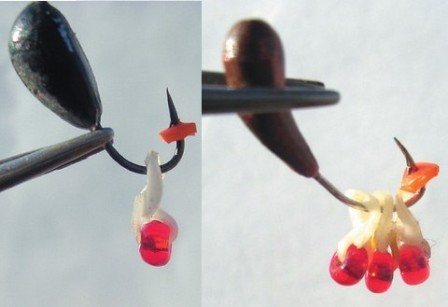
Advantages of a steam locomotive
The main advantage of such gear as the “locomotive” is the ability to fish several water horizons at the same time, which increases the effectiveness of the gear several times, which is reflected in a greater number of bites than with other gear. You can read the material about the types and characteristics of winter fishing rods.
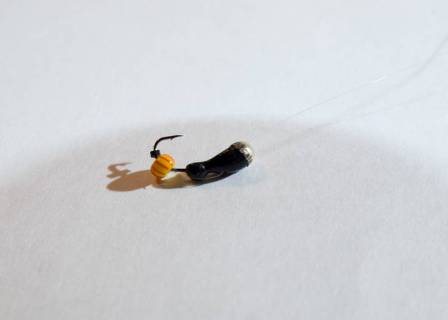
In addition, by varying the distance, number and size of baits attached to the fishing line, you can not only cover all depths, but also study the preferences of the inhabitants of the underwater kingdom in terms of the size of the bait. Some fish prefer large and clearly visible “devils”, while others have a greater appetite for medium and small jigs. You can read the material about winter fishing techniques.
Fishing technique
The biological characteristics of the perch, aggressiveness and curiosity, play a cruel joke on it. By combining a bastard with a known killer winter bait - a bully (or sharaga), we get a killer of perches in winter. You need to experiment with the equipment. Any winter perch bait (spinner, balancer, jig) is used as the heavy lower part. The fry is placed lower or higher on the main line with a palomar knot (or on a leash). The whitebait does not interfere with the work of the main bait, and during passive biting it saves fishing.
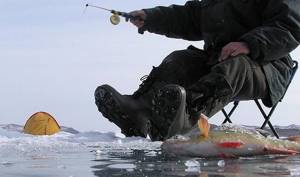
You can catch perch in winter using baits in conjunction with all other gear for trolling or jig fishing for this fish. Due to its small size and weight, the plug does not interfere with the work of heavy bait. The playing technique depends on the main trick used.
